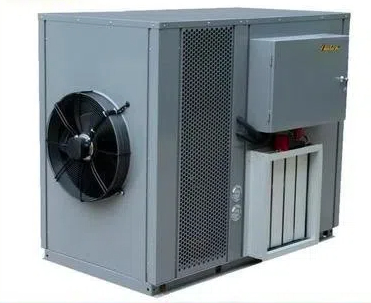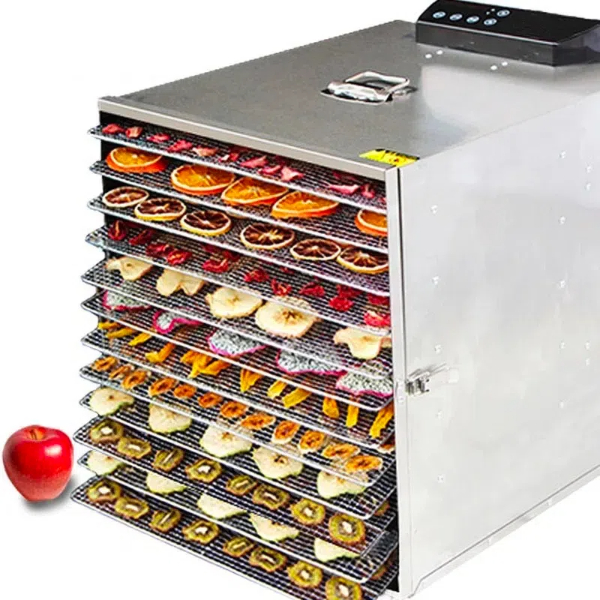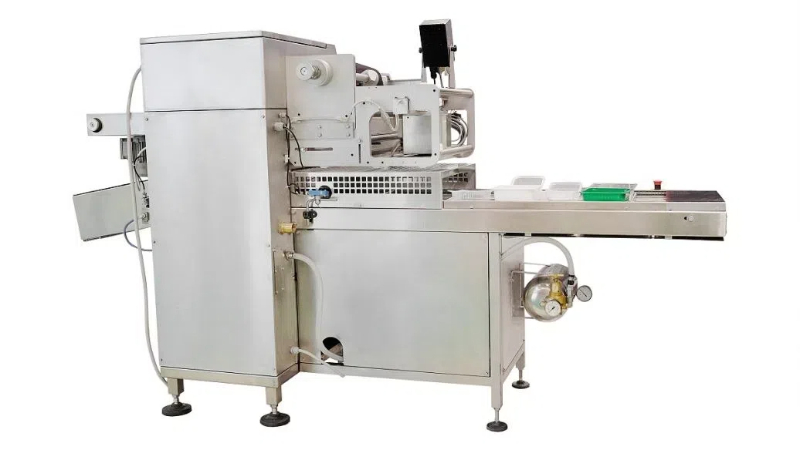
Content Menu
● Introduction
● Understanding Food Air Drying Technology
>> How Food Air Drying Machines Work
● Benefits of Using Food Air Drying Machines
>> 1. Extended Food Shelf Life
>> 2. Nutrient Preservation
>> 3. Space-Efficient Storage
>> 4. Cost-Effective Food Preservation
>> 5. Versatility in Food Preparation
● Types of Food Air Drying Machines
>> 1. Stackable Tray Dehydrators
>> 2. Box and Shelf Dehydrators
>> 3. Commercial Food Dehydrators
>> 4. Solar Food Dehydrators
● Choosing the Right Food Air Drying Machine
● Tips for Effective Food Air Drying
● Popular Foods for Air Drying
● The Future of Food Air Drying Technology
● Conclusion
● Frequently Asked Questions
>> 1. What is the optimal temperature for drying most fruits and vegetables?
>> 2. How long does it take to dry food in an air drying machine?
>> 3. Can I dry different types of food together in the same batch?
>> 4. How do I know when my food is properly dried?
>> 5. Is it necessary to pre-treat fruits before drying them in a food air drying machine?
Introduction
In the ever-evolving world of food preservation, food air drying machines have emerged as a game-changer. These innovative devices, also known as food dehydrators, have revolutionized the way we preserve fruits, vegetables, meats, and other food items. By harnessing the power of controlled air circulation and temperature, food air drying machines offer an efficient and effective method to extend the shelf life of various foods while retaining their nutritional value and flavor.
Understanding Food Air Drying Technology
Food air drying machines operate on a simple yet powerful principle: they remove moisture from food items through a controlled process of air circulation and heat application. This technology has been refined over the years, resulting in more efficient and versatile machines suitable for both home and industrial use.
How Food Air Drying Machines Work
A typical food air drying machine consists of several key components:
1. Heating element: Generates warm air to facilitate the drying process.
2. Fan: Circulates the warm air throughout the drying chamber.
3. Trays or racks: Hold the food items being dried.
4. Temperature control: Allows users to adjust the drying temperature based on the type of food.
5. Timer: Enables setting specific drying durations.
The process begins when food items are placed on the trays inside the drying chamber. The heating element warms the air, which is then circulated by the fan. As the warm air passes over the food, it absorbs moisture, gradually dehydrating the items. The continuous airflow ensures even drying and prevents the formation of hot spots.

Benefits of Using Food Air Drying Machines
1. Extended Food Shelf Life
One of the primary advantages of using a food air drying machine is the significant extension of food shelf life. By removing moisture, these devices create an environment inhospitable to bacteria, mold, and other microorganisms that cause food spoilage. Properly dried foods can last for months or even years when stored correctly.
2. Nutrient Preservation
Unlike some other preservation methods, air drying helps retain a significant portion of the food's original nutrients. The low-temperature drying process minimizes nutrient degradation, ensuring that vitamins, minerals, and other beneficial compounds remain intact.
3. Space-Efficient Storage
Dried foods occupy significantly less space than their fresh counterparts. This makes food air drying machines an excellent solution for those looking to maximize storage efficiency in their pantry or kitchen.
4. Cost-Effective Food Preservation
By allowing users to buy fresh produce in bulk during peak seasons and preserve it for later use, food air drying machines can lead to substantial cost savings. Additionally, they reduce food waste by extending the usability of fruits, vegetables, and other perishables.
5. Versatility in Food Preparation
Food air drying machines open up a world of culinary possibilities. From creating healthy snacks like dried fruit chips to preparing ingredients for soups, stews, and baked goods, these devices offer versatility in food preparation.
Types of Food Air Drying Machines
1. Stackable Tray Dehydrators
These are the most common type of food air drying machines for home use. They feature multiple trays that can be stacked vertically, allowing for the simultaneous drying of different food items. Stackable tray dehydrators are compact, easy to use, and ideal for small to medium-sized batches.
2. Box and Shelf Dehydrators
Box and shelf dehydrators resemble small ovens with removable shelves. They offer more space and are suitable for larger batches of food. These models often provide more precise temperature control and better air circulation, making them popular among enthusiasts and small-scale producers.
3. Commercial Food Dehydrators
Designed for industrial use, commercial food dehydrators are large-capacity machines capable of processing significant quantities of food. They feature advanced controls, multiple drying zones, and high-powered fans for efficient and uniform drying.
4. Solar Food Dehydrators
For those interested in eco-friendly options, solar food dehydrators harness the power of the sun to dry food. While they require specific weather conditions to operate effectively, they offer a sustainable alternative to electric models.

Choosing the Right Food Air Drying Machine
Selecting the appropriate food air drying machine depends on several factors:
1. Capacity: Consider how much food you plan to dry regularly.
2. Size and storage: Ensure the machine fits comfortably in your kitchen or storage area.
3. Temperature control: Look for models with adjustable temperature settings for versatility.
4. Energy efficiency: Check the power consumption, especially if you plan to use it frequently.
5. Noise level: Some models can be noisy, which may be a concern in household settings.
6. Ease of cleaning: Opt for machines with dishwasher-safe trays and easy-to-clean surfaces.
7. Additional features: Timer functions, automatic shut-off, and transparent doors can enhance usability.
Tips for Effective Food Air Drying
To get the most out of your food air drying machine, consider the following tips:
1. Prepare food properly: Wash, peel (if necessary), and slice foods uniformly for even drying.
2. Arrange food items with space between them to allow for proper air circulation.
3. Rotate trays periodically to ensure even drying, especially in stackable models.
4. Start with the recommended temperature and adjust as needed based on the food type.
5. Allow dried foods to cool completely before storing to prevent condensation.
6. Store dried foods in airtight containers in a cool, dark place to maximize shelf life.
Popular Foods for Air Drying
Food air drying machines are versatile and can be used to preserve a wide variety of foods:
1. Fruits: Apples, bananas, berries, mangoes, and pineapples are excellent choices for creating healthy snacks.
2. Vegetables: Carrots, bell peppers, onions, and tomatoes can be dried for use in soups, stews, and seasonings.
3. Herbs: Preserve the flavor of basil, oregano, thyme, and other herbs for year-round use.
4. Meats: Create jerky from beef, turkey, or fish for protein-rich snacks.
5. Nuts and seeds: Enhance flavors and extend shelf life of almonds, pumpkin seeds, and sunflower seeds.
The Future of Food Air Drying Technology
As technology continues to advance, we can expect to see further innovations in food air drying machines:
1. Smart features: Integration with mobile apps for remote monitoring and control.
2. Improved energy efficiency: Development of more eco-friendly models with lower power consumption.
3. Enhanced sensor technology: More precise humidity and temperature controls for optimal drying results.
4. Combination devices: Integration of air drying technology with other cooking methods like air frying or pressure cooking.
Conclusion
Food air drying machines have transformed the landscape of food preservation, offering an efficient, cost-effective, and nutritious way to extend the life of various food items. Whether you're a home cook looking to reduce food waste, a health enthusiast creating nutritious snacks, or a food business owner seeking to expand your product line, these versatile devices open up a world of possibilities. By understanding the technology, benefits, and best practices associated with food air drying machines, you can make informed decisions about incorporating this innovative preservation method into your culinary repertoire.
As we continue to seek sustainable and healthy food preservation methods, food air drying machines stand out as a valuable tool in our kitchens and food production facilities. Their ability to maintain nutritional value while significantly extending shelf life makes them an indispensable asset in our quest for better food management and reduced waste. Embrace the power of food air drying technology and discover a new dimension in food preservation and preparation.

Frequently Asked Questions
1. What is the optimal temperature for drying most fruits and vegetables?
Answer: The optimal temperature for drying most fruits and vegetables in a food air drying machine typically ranges between 125°F to 135°F (52°C to 57°C). This temperature range is high enough to remove moisture effectively while low enough to preserve nutrients and prevent case hardening (when the outside dries too quickly, trapping moisture inside).
2. How long does it take to dry food in an air drying machine?
Answer: The drying time can vary significantly depending on the food type, its water content, the thickness of the slices, and the specific machine used. On average, fruits may take 6 to 16 hours, vegetables 4 to 12 hours, and meats (for jerky) 4 to 15 hours. It's important to check your food periodically and follow recipe guidelines for best results.
3. Can I dry different types of food together in the same batch?
Answer: While it's possible to dry different types of food together, it's generally not recommended. Different foods often require different drying times and temperatures. Additionally, flavors can transfer between foods during the drying process. For best results, dry similar foods together and clean the trays thoroughly between batches of different food types.
4. How do I know when my food is properly dried?
Answer: Properly dried food should be leathery or crisp, depending on the type. Fruits should be pliable and leathery with no pockets of moisture. Vegetables should be tough or crisp. Meats should be dry and leathery but not brittle. You can also test by cutting pieces in half – there should be no visible moisture and it shouldn't feel cool to the touch.
5. Is it necessary to pre-treat fruits before drying them in a food air drying machine?
Answer: Pre-treating fruits before drying is often recommended but not always necessary. Pre-treatment can help maintain color, texture, and nutritional value, and it can also extend the shelf life of the dried product. Common pre-treatment methods include dipping in lemon juice or ascorbic acid solution, blanching, or sulfuring. However, some fruits like berries can often be dried without pre-treatment.












